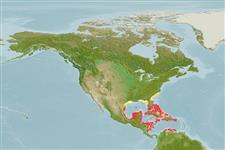Classification / Names
Common names from other countries
Main reference
आकार / वज़न / Age
Max length : 76.0 cm TL पुल्लिंग / अलिंग; (Ref. 9710)
पर्यावरण
; समुद्री प्रवाल-भित्ति संयुक्त; गहराई सीमा 1 - 25 m (Ref. 9710)
जलवायु / सीमा
Tropical, preferred ?; 36°N - 11°N, 100°W - 66°W (Ref. 55316)
वितरण
Short description
Edge of disk no sharp angles, no dorsal fin. Well-developed caudal fin extends around tip of tail, doubly serrate spine near caudal fin base (Ref. 26938). Disk yellowish, with dark vermiculations and spots that form a variety of patterns on upper surface (Ref. 7251). Lower surface is yellowish, greenish or brownish white, tail with dark spots (Ref.6902).
IUCN Red List Status (Ref. 115185)
Threat to humans
Venomous
Human uses
जलजीवालय: सार्वजनिक लजीवालय
अधिक जानकारी
संदर्भजलीयकृषिजलीयकृषि रूपरेखाखींचआनुवंशिकीऐल्लि आवृतियाँहैरेटिबिलटीबीमारीप्रक्रमणMass conversion
सहयोगीयोतस्वीरेStamps, Coinsध्वनिसिगुयटिरारफ्तारतैरने के प्रकारगिल क्षेत्रOtolithsदिमागदृष्टि
साधन
Special reports
Download XML
इंटरनेट स्रोत
Estimates of some properties based on models
Phylogenetic diversity index
PD50 = 0.5156 many relatives (e.g. carps) 0.5 - 2.0 few relatives (e.g. lungfishes)
Trophic Level
3.6 ±0.51 se; Based on food items.
लौटाव
Vulnerability
Low to moderate vulnerability (32 of 100)
Price category
